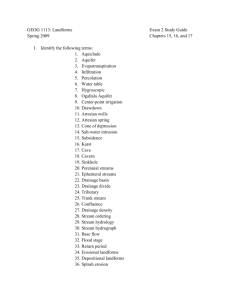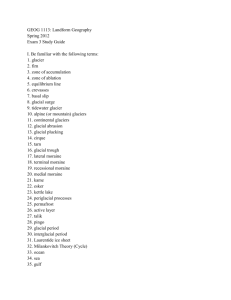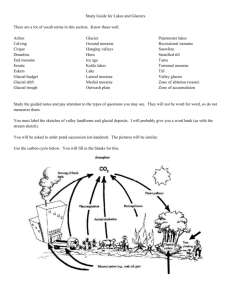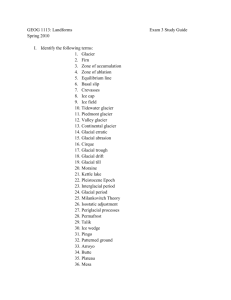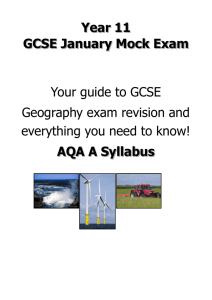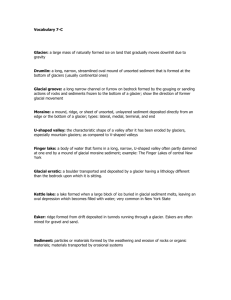Updated Exam 3 Study Guide
advertisement
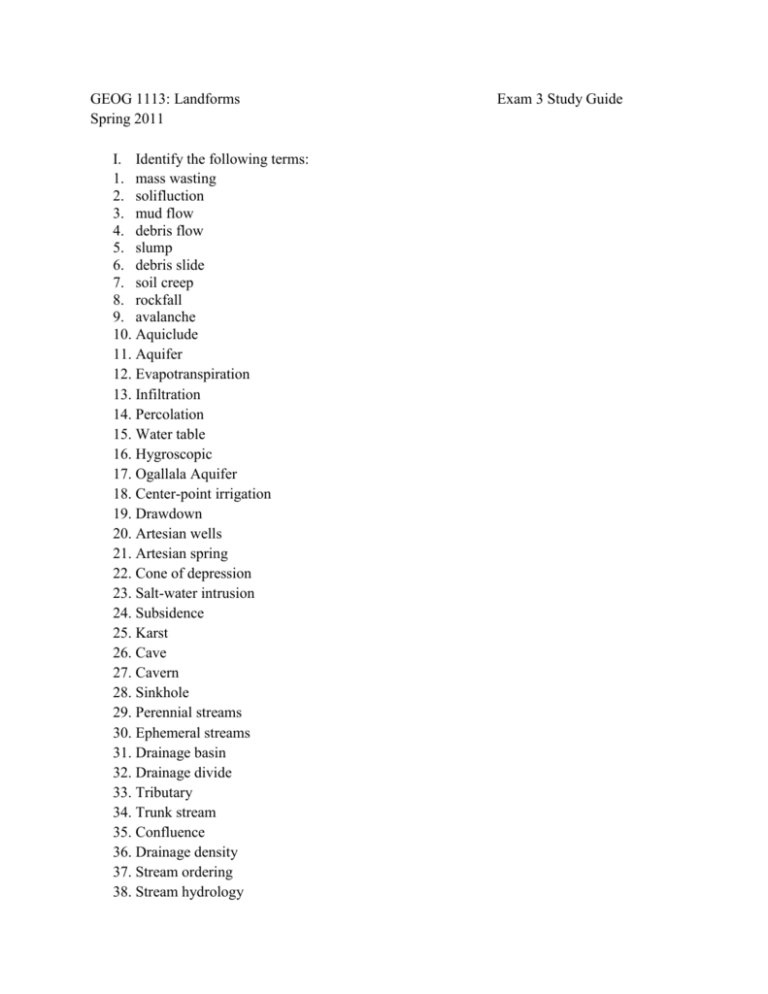
GEOG 1113: Landforms Spring 2011 I. Identify the following terms: 1. mass wasting 2. solifluction 3. mud flow 4. debris flow 5. slump 6. debris slide 7. soil creep 8. rockfall 9. avalanche 10. Aquiclude 11. Aquifer 12. Evapotranspiration 13. Infiltration 14. Percolation 15. Water table 16. Hygroscopic 17. Ogallala Aquifer 18. Center-point irrigation 19. Drawdown 20. Artesian wells 21. Artesian spring 22. Cone of depression 23. Salt-water intrusion 24. Subsidence 25. Karst 26. Cave 27. Cavern 28. Sinkhole 29. Perennial streams 30. Ephemeral streams 31. Drainage basin 32. Drainage divide 33. Tributary 34. Trunk stream 35. Confluence 36. Drainage density 37. Stream ordering 38. Stream hydrology Exam 3 Study Guide 39. Stream hydrograph 40. Base flow 41. Flood stage 42. Return period 43. Erosional landforms 44. Depositional landforms 45. Alluvial fan 46. Glacier 47. Firn 48. Zone of accumulation 49. Zone of ablation 50. Equilibrium line 51. Basal slip 52. Crevasses 53. Ice cap 54. Ice field 55. Tidewater glacier 56. Piedmont glacier 57. Valley glacier 58. Continental glacier 59. Glacial erratic 60. Glacial abrasion 61. Cirque 62. Glacial trough 63. Glacial drift 64. Glacial till 65. Moraine 66. Kettle lake 67. Pleistocene Epoch 68. Interglacial period 69. Glacial period 70. Milankovitch Theory 71. Isostatic adjustment 72. Periglacial processes 73. Permafrost 74. Arroyo 75. Butte 76. Plateau 77. Mesa 78. Pinnacle 79. Playa 80. Eolian 81. Desert pavement 82. Deflation hollow 83. Dust Bowl 84. Desertification 85. Loess 86. African Sahel 87. Ocean 88. Sea 89. Gulf 90. Bay 91. Salinity 92. Brine 93. Brackish 94. Eustatic change 95. Ria 96. Fjord 97. Tides II. 1. 2. 3. 4. 5. 6. 7. 8. 9. Short Answer: Name and describe the 2 primary types of weathering Name and describe the 5 types of physical weathering Name and describe the 4 types of chemical weathering Explain what is causing drawdown in the Ogallala Aquifer. Give 3 sources of groundwater contamination. Where can karst landforms be found? What are the 3 sources of stream water? Name and describe the 4 primary drainage patterns we discussed in class. Explain stream ordering. What happens when 2 order 1 streams meet? When 2 order 2 streams meet? When an order 1 and order 2 stream meet? 10. Why would stream discharge vary with season? 11. If you live on the 100-year floodplain, what is the likelihood that your house will flood this year? 12. Explain why the upper Midwest is prone to flooding by the Mississippi River. 13. Explain the difference between a gully, canyon, rill, and ravine. 14. Give 2 examples of depositional landforms and 2 examples of erosional landforms. 15. Explain the importance of alluvial fans to western cities. 16. In the Glacial Mass Budget, what is glacial input and what is glacial output? 17. Briefly explain how glaciers are formed. 18. How do glaciers move? 19. Why does the Pacific Northwest having glaciers that are growing? 20. Name and describe the 2 types of glacial drift. 21. Why is Minnesota the Land of 10,000 Lakes? What kinds of lakes are these? 22. How are oxygen isotopes used to reconstruct glacial history? 23. Name and describe the significance of the 5 possible causes of glaciations. 24. Explain the seasonal changes in the active layer. 25. What are the 3 factors (or where are the 3 areas) influencing arid climates? 26. Why are flash floods common in arid regions? 27. How are playas formed? 28. Name and describe the 2 types of wind erosion. 29. Explain the importance of loess 30. Explain how Humans can cause desertification 31. Name the world’s 5 oceans 32. Explain why the Earth has tides. III. Diagrams: 1. Illustrate the fate of precipitation on soil (The Groundwater Model). Include the following terms in your illustration: evapotranspiration, runoff, infiltration, percolation, groundwater, water table, saturated zone, unsaturated zone 2. Illustrate the relationship between Aquifers and Aquicludes. Include the following terms in your illustration: aquifer, aquiclude, water table, bedrock, saturated zone, unsaturated zone, recharge area. 3. Illustrate a small drainage basin. Include the following in your illustration: drainage divide, tributary, confluence, trunk stream. 4. Illustrate a glacial mass budget. Include the following in your illustration: zone of accumulation, zone of ablation, equilibrium line, evaporation, sublimation, meltwater, crevasse. 5. Illustrate glacial depositional landforms. Include the following in you illustration: terminal moraine, recessional moraine, lateral moraine, medial moraine, glacier.



